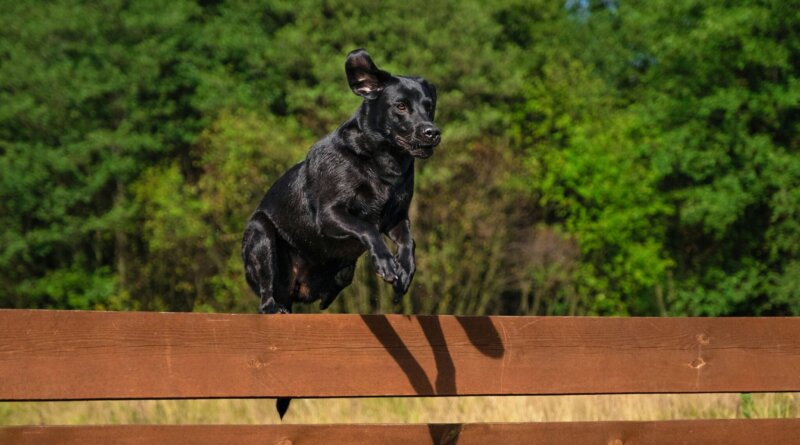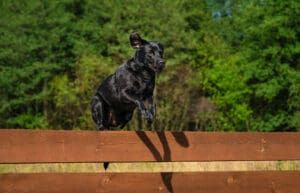How to Keep a Dog from Jumping the Fence
A fenced yard can be great when you have a dog. It gives them a safe place to play, relieve themselves, and enjoy being outside as well as providing a reasonably controlled environment for training, exercise, and enrichment activities. However, that safety can disappear quickly if your dog finds a way to get out of the yard.
It’s safe to assume that if a dog can get over, under, or through a barrier, she will. This raises the question of how to keep a dog in the yard once she figures out how to beat the fence. To be honest, the only reliable way to keep a dog from jumping the fence is to build a better fence. Training your dog to respect boundaries can help, but there is no way to guarantee that training will hold if something frightening or exciting happens while you are not there to reinforce the behavior you expect.
Why Dogs Escape
Identifying the cause of the problem won’t change how to keep a dog in the yard; to reiterate, if a dog is capable of getting out, always assume the time will come when she will. However, having an idea of what motivates your dog might offer some insight into how to improve her life overall. While the human/canine communication barrier prevents us from knowing exactly why a specific dog might decide to leave when an opportunity presents itself, we can make some educated guesses:
- Boredom: A dog who is not getting enough stimulation may feel the need to go look for something better to do than hanging around in the same old space doing the same old things.
- Loneliness: While some dogs are fine by themselves, others don’t like to be alone for long periods of time. If company can be found outside the yard, then over the fence they will go if they can manage it.
- Separation anxiety: A dog experiencing separation anxiety may attempt to get back to where she feels safe – namely, with her humans. If this seems like it might be why your dog is trying to escape, it’s time to stop putting her out in the yard alone and first work on resolving her anxiety. Anxiety and fear can drive a dog to extreme measures such as flinging herself at the fence, biting or tearing at barriers, or forcing her way through too-small gaps.
- Fear: Similarly, if something in the yard scares a dog to the point where she feels the need to escape, she will be very motivated to find a way out, fence or no fence.
- External stimulation: There are a plethora of things that can trigger a dog’s desire to approach something they can’t reach because of the fence. Whether it’s chasing squirrels or wanting to get to another dog or human, seeing something on the other side can create a need to get out.
- Fun: Sometimes the grass just looks greener on the other side. Exploring can be reason enough to go wandering even if there is plenty of fun stuff to do at home.
Good Fencing for Dogs
While no barrier is perfect, a good fence will go a long way toward keeping your dog in and other animals and humans out. Things to consider when assessing fencing for dogs include:
- Your dog: Step one is to observe your dog, keeping in mind any traits or behaviors that might play a role in how she interacts with a fence. For example, an energetic, athletic dog may need a taller, stronger fence than one who just wants to laze around in the sun when outside. That goes double for a dog who has shown signs of wanting to jump or climb. On the other end of the fence, a small dog or a dog who wants to dig may need something that sits flush with or below ground level. Keep in mind that a puppy or a dog who is new to the household may become more willing to test the fence as she gains confidence.
- Fence height: While 6 feet is generally considered a safe bet for most dogs, there is no fool-proof guide to guessing the right fence height. Typically, taller dogs call for taller fences, but there are plenty of small dogs that can get some serious airtime and they have less mass to weigh them down when climbing. It’s worth noting that the current record holder for “highest jump by a dog” logged a leap of 75.5 inches (6.3 feet). The record was set for a clean jump; if a dog can get a paw on something to give them a lift, or jump high enough to get paws over a support and climb the rest of the way, even a 6-foot fence might not be enough if you’ve got a real athlete on your hands.
- Fence add-ons: For a determined climber or digger (see the sidebar below), there are some options to help keep them from getting out. An inward slanting panel at the top of a fence can make it harder to climb over while a concrete strip or L-shaped footer buried underground can serve to keep a digger contained.
- Gaps and spacing: Pay attention to any gaps in the fencing, particularly at corners, gates, and where the fence meets the ground. Also note how closely spaced the fencing material is. A good rule of thumb is that if the dog can get her head through, the rest of her could follow.
- Material: Discussing the pros and cons of fencing materials could be an article unto itself. In short, the best option depends a lot on the dog, location, and available budget. Of the more commonly used materials, chain link and other metal mesh fences are durable, low-maintenance, and often more budget friendly. However, they are climbable, flexible, and often have gaps at gates or corners. Wooden panel fencing provides more privacy and less external stimulation, but tends to require more maintenance, especially in harsher climates. It can also be chewable and provide purchase for determined climbers. Vinyl panel fencing is lower maintenance and longer-lasting than wood while offering many of the same benefits. It is also slippery enough to make climbing difficult, but can be more expensive and harder to repair if damaged. Brick or stone walls are great for containing dogs but can get very pricey, especially if they need to be taller than a few feet.
Extending Existing Fencing
When it comes to extending a fence your dog has already (or nearly) escaped, half measures generally won’t cut it. For example, if you were to add only a foot to a fence your dog has jumped or climbed over before, you may end up encouraging her to just try harder next time. The same goes for diggers; a footer that goes a short way past the depth your dog dug to previously might actually teach her to dig deeper. Also, filling in or reinforcing only the spot your dog dug out of may push her to try other spots along the fence instead. To be effective, fence extensions need to be significant to stand a chance.
Two Types of Canine Escape Artists
There are two individuals in my dog history – both beloved residents of the family kennel – that came immediately to mind when I started writing this article. The first, Lupe, was a joyful and relentless digger. She tunneled everywhere – in between runs in the kennel (which then had packed pea-gravel footing), under fences separating the dog yards, and out under the main dog paddock fence. She was also a big fan of bringing friends. If she was in the yard with a buddy, she’d urge them through the hole. If she was solo, she’d dig into another run or yard before heading out to explore the neighborhood. We were very, very lucky that nobody got hurt or lost before we figured out that she could and would go through pretty much anything even remotely diggable the moment her humans turned their backs.
Lupe has the honor of being the impetus for one of the kennel’s most expensive fencing renovations to date. In order to make a safe place for her (and her daughter, who picked up her mother’s hobby), we ended up renting a backhoe and digging a trench around the perimeter of every fence on the property meant to contain a dog. From there, we installed L-shaped panels that extended two feet below ground and one foot in. Lupe spent six months spot testing the new fence before deciding her digging efforts were better spent on gopher holes.
The second, Blue, was a climber. In his case, we didn’t figure that out for a while. He came to us as a rescue with a plethora of tick-borne illnesses. Recovery was slow but when his energy finally started to come back, he began climbing the fences, which were mostly chain link or wire mesh over wood. In his case, the climbing seemed to be motivated by separation anxiety. Especially in the early days, when he was still learning that we were his and he was ours, he really struggled with not having a human in sight and would do what he felt he needed to do to fix that – including scaling 6-foot chain link.
Trust-building and training helped him to feel more comfortable and eventually he was able to happily spend time in the yard, but he was always a climber. We ended up adding a chain link roof to one of the outdoor dog runs so he would have a safe place to hang out and get some fresh air without us being right there with him.
The Dangers of Tie-outs and Invisible Fences
It may be tempting to look for other ways to restrain your dog outside if existing fencing isn’t doing the trick, especially since a new, dog-safe fence can be a major expense. Unfortunately, there aren’t many good options available.
While it was once a commonly used approach, leaving a dog outside on a line or chain puts her at significant risk of injury. First, it’s too easy for a dog to get tangled in the line, even if there aren’t any obvious objects to get stuck on. If the line gets wrapped around a leg, or worse, around the dog’s neck, it can cause sprains, broken bones, or strangulation. There is also the risk of neck and back injuries if the dog were to get jerked to a sudden stop by outrunning the length of line or chain.
Electronic “invisible” fences, which usually work by supplying a shock, vibration, or sound via a special collar when the dog goes past the set boundary, aren’t a good way to go either. Even if you pick a “pain free” option that cues the dog with sound or vibration and provide training based on positive associations, it comes back to the question of “Will it hold when something scary or thrilling happens?” Let’s say a loose dog comes running through the barrier (which he can’t see or feel) and starts a fight with your dog. In the fear and confusion, how likely is it that your dog will remember her training and prioritize staying within the boundary over her own life?
What to Do if You Don’t Have a Dog-Proof Fence
Whether it’s the expense, the circumstances (such as rental property rules), or if you’ve just found yourself sharing your life with an incredible dog who can get through anything not designed to hold a grizzly bear, building a better fence isn’t always possible. It’s worth remembering that a fenced yard is not a requirement for giving your dog a good life. As long as you are able to provide her with appropriate exercise and enrichment through walks, training, and other activities, she doesn’t need to be loose in a yard to be happy and healthy.





